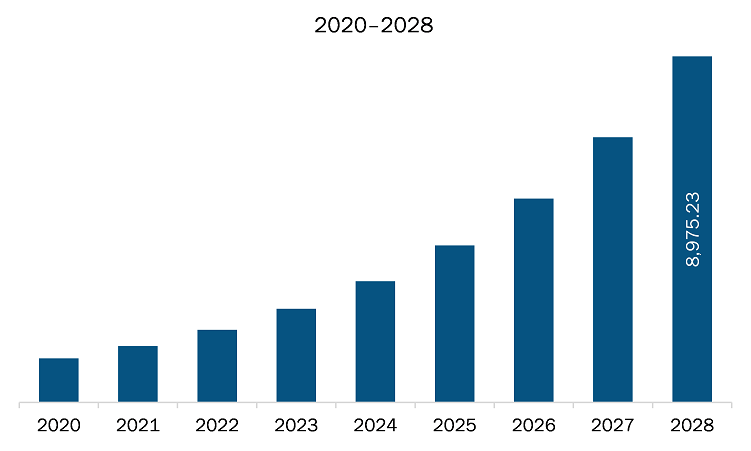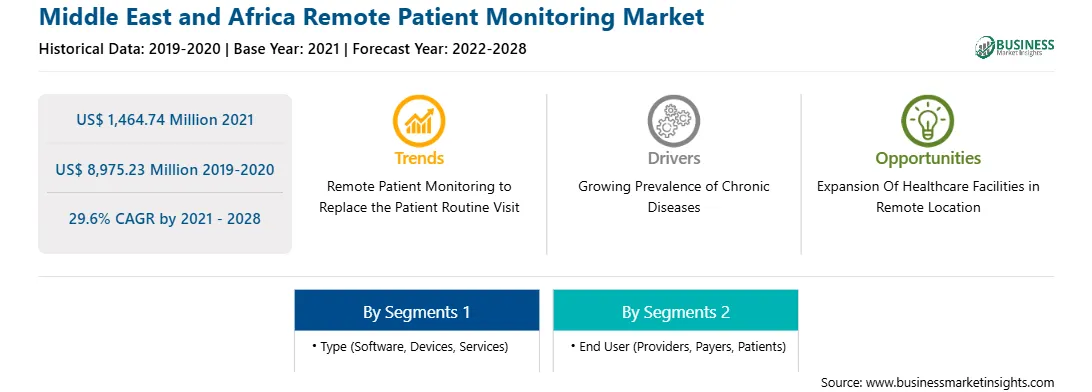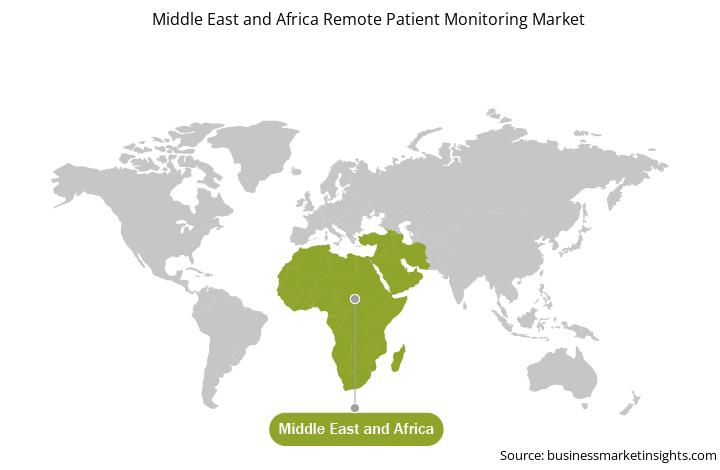Middle East & Africa remote patient monitoring market is analyzed based countries such as Saudi Arabia, UAE, South Africa, and Rest of Middle East & Africa. The Saudi Arabia is accounting for the largest market share in the region. Saudi Arabia is among the well-developed economies, which have the fastest-growing medicals sector. The country invests more in developing its healthcare facilities across the country. The annual spending on healthcare has increased by 21.1% in the last nine years. The country has the presence of various international players that operates in Saudi Arabia. The rising prevalence of cardiovascular diseases is of the major concern in Saudi Arabia. It is hindering the social aspects of life as well hindering the economy. As per the report published by the Saudi Gazette stated that the prevalence of cardiovascular diseases in the Saudi Arabia accounted nearly 36% of deaths whereas nearly 13% of disability were on account of cardiovascular diseases. Therefore, it is expected that demand for the patient monitoring devices is likely to grow in the forecast period. The Saudi market for medical devices is projected at just under USD 2 billion and is growing annually, approximately 10 percent. Greater awareness of health issues and increasing consumption of healthcare services sustain a substantial market for medical equipment.
The Middle East & Africa includes countries like the UAE, South Africa and Saudi Arabia have also registered many positive coronavirus infection cases. These regions are developing in terms of the healthcare and medical service industry. The countries in these regions are highly dependent on medical devices and pharmaceutical products imported from developed countries. Therefore, countries have faced several challenges with their requirements for patient monitoring devices due to severe disruption in supply chains. The COVID-19 treatment and health monitoring procedures have been developed and are efficiently used to reduce the death rate due to COVID-19. The respiratory and cardiac monitoring remote devices is readily available on online retail platforms such as the online pharmacy and other online retail outlets. The governments in the world are upgrading patient monitoring systems to tackle the challenges during COVID-19 patients. For instance, the Dubai Health Authority utilizes a Masimo Patient SafetyNet system capable of wireless transfer of patients' data from monitoring devices such as Masimo Root with the Radical-7, wearable Radius-7, Pulse CO-Oximeter. Thus, availability and use of advanced patient monitoring devices in the developing countries and regions are expected to have a positive impact on the markets.

Strategic insights for the Middle East and Africa Remote Patient Monitoring provides data-driven analysis of the industry landscape, including current trends, key players, and regional nuances. These insights offer actionable recommendations, enabling readers to differentiate themselves from competitors by identifying untapped segments or developing unique value propositions. Leveraging data analytics, these insights help industry players anticipate the market shifts, whether investors, manufacturers, or other stakeholders. A future-oriented perspective is essential, helping stakeholders anticipate market shifts and position themselves for long-term success in this dynamic region. Ultimately, effective strategic insights empower readers to make informed decisions that drive profitability and achieve their business objectives within the market.

| Report Attribute | Details |
|---|---|
| Market size in 2021 | US$ 1,464.74 Million |
| Market Size by 2028 | US$ 8,975.23 Million |
| Global CAGR (2021 - 2028) | 29.6% |
| Historical Data | 2019-2020 |
| Forecast period | 2022-2028 |
| Segments Covered |
By Type
|
| Regions and Countries Covered | Middle East and Africa
|
| Market leaders and key company profiles |
The geographic scope of the Middle East and Africa Remote Patient Monitoring refers to the specific areas in which a business operates and competes. Understanding local distinctions, such as diverse consumer preferences (e.g., demand for specific plug types or battery backup durations), varying economic conditions, and regulatory environments, is crucial for tailoring strategies to specific markets. Businesses can expand their reach by identifying underserved areas or adapting their offerings to meet local demands. A clear market focus allows for more effective resource allocation, targeted marketing campaigns, and better positioning against local competitors, ultimately driving growth in those targeted areas.

The remote patient monitoring market in Middle East & Africa is expected to grow from US$ 1,464.74 million in 2021 to US$ 8,975.23 million by 2028; it is estimated to grow at a CAGR of 29.6% from 2021 to 2028. With a rise in cases of chronic illnesses such as diabetes and hypertension, there has been a rise in health awareness among population. Also, in recent days, there has been a significant rise in the number of individuals suffering from heart related disorders. These factors have led to increase in the importance of maintaining health among the population in the developed and developing nations. The demand for various health monitoring devices for tracking health status has increased significantly in the recent years. Also, there has been a rise in number of specialty clinics and home healthcare business in the region. Saudi Arabia which is anticipated to propel the adoption of remote patient monitoring devices during the forecast period. Also, due to an increase in the disposable income as well as the rate of urbanization in the leading economies such as the Saudi Arabia, the market is expected to experience growth opportunities. The use of handheld and wearable devices for monitoring vital signs has been increased among the old age population as well as millennial. Owing to the growth in awareness regarding health, the market for remote patient monitoring devices is anticipated to witness significant growth during the forecast period.
In terms of type, the devices segment accounted for the largest share of the Middle East & Africa remote patient monitoring market in 2021. In term of end user, provider segment held a larger market share of the remote patient monitoring market in 2021.
A few major primary and secondary sources referred to for preparing this report on the remote patient monitoring market in Middle East & Africa are company websites, annual reports, financial reports, national government documents, and statistical database, among others. Major companies listed in the report are Koninklijke Philips N.V.; Nihon Kohden Corporation; Medtronic; General Electric; Cerner Corporation; Siemens Healthineers AG; Boston Scientific Corporation; Omron Healthcare; and Abbott among others.
The Middle East and Africa Remote Patient Monitoring Market is valued at US$ 1,464.74 Million in 2021, it is projected to reach US$ 8,975.23 Million by 2028.
As per our report Middle East and Africa Remote Patient Monitoring Market, the market size is valued at US$ 1,464.74 Million in 2021, projecting it to reach US$ 8,975.23 Million by 2028. This translates to a CAGR of approximately 29.6% during the forecast period.
The Middle East and Africa Remote Patient Monitoring Market report typically cover these key segments-
The historic period, base year, and forecast period can vary slightly depending on the specific market research report. However, for the Middle East and Africa Remote Patient Monitoring Market report:
The Middle East and Africa Remote Patient Monitoring Market is populated by several key players, each contributing to its growth and innovation. Some of the major players include:
The Middle East and Africa Remote Patient Monitoring Market report is valuable for diverse stakeholders, including:
Essentially, anyone involved in or considering involvement in the Middle East and Africa Remote Patient Monitoring Market value chain can benefit from the information contained in a comprehensive market report.